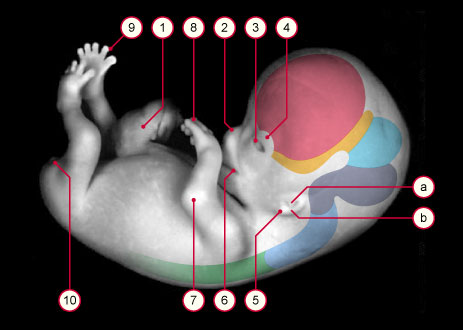
1
2
3
4
5
6
7
8
9
10 |
Umbilcal cord with hernia
Nose
Eye
Eyelid
Ear (a: tragus, b: antitragus )
Mouth
Elbow
Finger
Toes
Atrophied embryonic tail bud |
|
 |
Telencephalon |
 |
Diencephalon |
 |
Mesencephalon |
 |
Metencephalon |
 |
Myelencephalon |
 |
Spinal cord |
|
|
|
Characteristic signs:
Angle between the head and trunk amounts to 30°
The head makes 50% of the embryo's size
The head is rounded, the extremities lengthened and stand out from the body
Chin
Nasal pit
Development of the external genital primordium |
© Professor Kohei Shiota, Kyoto University
|
|